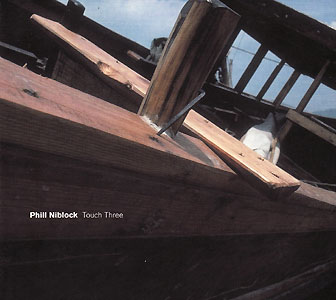
 |
|
 |
Format: 3 x CD Label & Cat.Number: Touch TO:69 Release Year: 2006 Note: Great, monumental work by the drone-minimalist from New York, 9 long pieces spread on 3 CDs based on instrumental sounds performed by different musicians, NIBLOCK formed 24-32 track pieces out of this, with no further electronic processing: Reine Klänge, Wellen, Frequenzen, Fliessen, Obertöne - Statik die sich bewegt, wie sie einnehmender kaum sein könnte-mal sehr nah, dicht und konkret, mal orchestral vielschichtig und polyphon....benutzte Instrumente: Cello, Akustikgitarre, Saxophon, Trompete, Viola...
Price (incl. 19% VAT): €22.50 More InfoGrossartiges, monumentales Werk des New Yorker Drone-Minimalisten, z.T. fürs Deutschland Radio Köln produziert.. Neun lange Drone-Stücke auf 3 Cds verteilt, die auf von verschiedenen Musikern eingespielten Instrumentalsounds beruhen. NIBLOCK hat daraus 24 - 32 Spuren-Stücke gemacht, die elektronisch nicht weiter verfremdet wurden. Reine Klänge, Wellen, Frequenzen, Fliessen, Obertöne - Statik die sich bewegt, wie sie einnehmender kaum sein könnte… mal sehr nah, dicht und konkret, mal orchestral vielschichtig und polyphon....benutzte Instrumente: Cello, Akustikgitarre, Saxophon, Trompete, Viola.."Touch Three is minimalism in the classic sense of the word, if that makes sense. Niblock constructs big 24-track digitally-processed monolithic microtonal drones, and the result is sound without melody or rhythm. Movement is slow, geologically slow. Changes are almost imperceptible, and his music has a tendency of creeping up on you. The vocal pieces are like some of Ligeti's choral works, but a little more phased. He says: "What I am doing with my music is to produce something without rhythm or melody, by using many microtones that cause movements very, very slowly." These nine pieces were made from March 2003 to January 2005. They were all made (except "Sax Mix") by recording a single instrument with a single microphone. The recordings were direct to the computer/hard disk, most of them using a Powerbook G4, Pro Tools, an M-box and an external firewire drive. The resulting mono sound files were edited to remove breathing spaces, leaving the natural decay of the tone, and the attack of the subsequent iteration of the same tone. Each note was represented by several repetitions, perhaps ten for each tone, of about 15 seconds duration each. Each piece uses a few tones. A simple chord, perhaps. Additional microtonal intervals were produced in Pro Tools using pitch shift. The pieces were assembled in multitracks, usually either 24 or 32 tracks. The recording environment varied from a simple apartment in Berlin (Ulrich Krieger's) to a very large hall used for symphony orchestra performances and recordings, with a sizable audience space. The recordings were generally done quite closely miked. One hears only the sound of the instrument. There is no electronic manipulation in the recording, the editing of the tones, or in the mix. The only changes to the recorded tones are the pitch shifts to create microtones...the microtones are doing the work." [press release] " Ever since I am a keen follower of his work, and this new 3CD set is just an overwhelming release. The idea is very simple, for each of the pieces on this CD. Recorded a few tones of one instrument, remove the breathing, leaving the decay and then change the pitch on some of the sounds. Then Niblock starts to layer these tracks, usually somewhere between 24 and 32 tracks. No other electronic processing was done to these recordings. Among the instruments used here we find cello, acoustic guitar with e-bow, recorders, alto/soprano/baritone saxophones, trumpet and viola. A typical Niblock piece lasts between 20 and 22 minutes. All clear, neat and simple? Then why release three CDs, nine tracks in total? They probably all sound the same anyway? Well, of course it less simple and of course it sounds different. The CD open with 'Sethwork' (check out Phill's website for the correct order of the tracks on CD one!), which is almost classical Phill Niblock: sustained tones, with hardly a pause and apparently played on 'acoustic, unamplified guitars with e-bow'. A continuos deep hissing (for the lack of a better word) sound. This is how Niblock sounded when I first heard his music, almost twenty-five years ago. Compared that with 'Harm', also on the first CD, which is a work for cello (which is one of Niblock's beloved instruments). Now here the sounds are highly sustained too, but in stead of one mighty block of sound, it almost sounds orchestral, with the sounds coming in and out of the mix. Two totally different approaches to the same technique. With a slight adjustment, leaving some space at the beginning and end of each sound, Niblock adds on 'Parker's Altered Mood, aka, Owed To Bird', the sound of inhaling breath (in order to play the alto saxophone), which add yet another dimension to this music. Maybe playing all three CDs in this set is a bit much, but I did it, and I must say time disappeared as this overwhelming unfolded little by little. Simply the best Niblock statement thus far, the most complete one.” [FdW / Vital Weekly] |
| © 2007 Drone Records | | Celler Strasse 33, 28205 Bremen, Germany | Privacy and cookies policy | Impressum / Allgemeine Geschaftsbedingungen / Haftungsausschluss | Links to the scene |